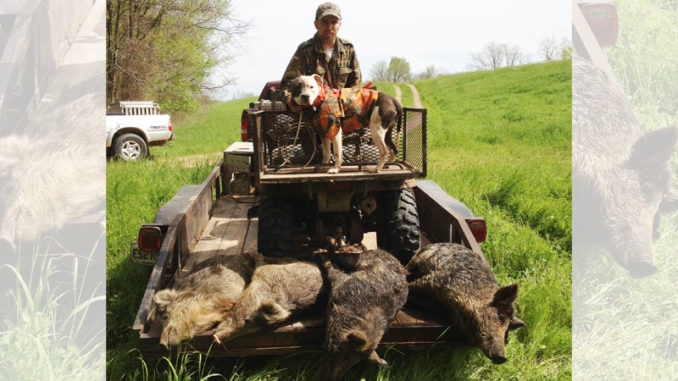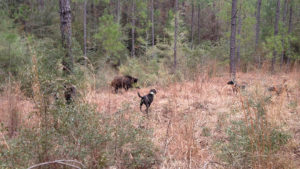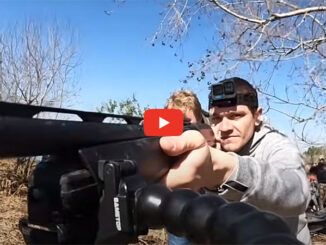
Fill the upcoming void in hunting seasons by hog-dogging
As deer seasons start to wind down and come to a close, we always look for a way to fill the void between chasing bucks and spring gobbler hunting, or fishing for spawning bass. We’ve talked before about using this time to reduce the overabundant feral hog numbers, and put some pork in the freezer at the same time.
For most folks, the two most common and effective methods for thinning the herd are shooting and trapping. But some of us with unusual ideas about what we call fun eagerly look forward to late-winter and early-spring for one reason: It’s prime time for hog dogs.
I was lured into the sport many years ago after a relative and long-time hunting partner turned to hunting hogs with dogs as the popularity of running deer with hounds sharply declined. It didn’t take much time to get hooked on the roar of bayed dogs echoing through the woods, and by spring I was raising cur dog pups.
A southern tradition
Hunting hogs with dogs evolved from the days of early settlers, when domestic hogs roamed freely throughout the South. Those hogs were not wild by any stretch. They primarily stayed close to home, ranging only as far as needed to feed, water or find a cool place to spend hot days. Dogs were used to locate the hogs and drive them home, or keep the adult sows and boars at bay while smaller pigs were sorted, neutered and marked with the owner’s distinctive ear mark. Read Fred Gipson’s “Old Yeller” for more on how hogs were worked with dogs.
Over time (and for reasons not entirely understood), the woods hog evolved from recognizable domestic breeds to the feral and destructive hogs overrunning wildlife habitat today. As the feral hog has evolved and changed, so too has the hog dog and the way it does its job.
Not your grandad’s collie

I often heard my granddad and dad tell stories about the dogs they had on the farm. Some of the best were collies trained to herd and handle cows and hogs. My grandad kept a collie long after he no longer needed one for cattle or hogs. They were smart, gentle dogs that could herd stock, and knew better than to bite or injure pigs or calves.
Today’s hog dog is different. Most, but not all, are curs, and while most people think of Catahoula curs as encompassing all cur dogs, they do not.
The short explanation is that all Catahoulas are curs, but not all curs are Catahoulas. But cur or not, a good hog dog has a keen nose and will stay on a track until finding and baying the hog. If the hog won’t hold and tries to run or drift away, the dog will use his teeth to stop the hog — but won’t maul it to death. And it will keep the hog at bay until the hunters arrive with the catch dogs.
Catch dogs have a different role. They are held on a leash, wear body armor, and walk up to the bay with the hunters. Most are some breed of bulldog. When released they run in and latch onto the hog, usually grabbing an ear. They hang on while the hunters run in, catch the hog, and throw and tie it. Thus, the name “catch-and-tie hunting” — and yes, it’s a hoot.
Benefits of dogging hogs
Why, one might ask, would anyone want to hunt hogs with dogs? Well, there are benefits to both the landowner and wildlife. Hogs are smart, and they don’t like dogs. One thing we know for sure is not bothering to return to an area where dogs found hogs for a while. The hogs will be long gone, having packed up and moved to quieter surroundings.
That fact is of particular benefit to farmers and ranchers dealing with crop- and pasture-raiding hogs, and wildlife managers who prefer deer to hogs. Hog dogs move the problem, at least temporarily, but far more effectively than trapping and shooting. I have landowner friends who call, on average, four to five times a year when hogs show up on their property. We will make a hunt or two and give them some relief for a couple of months, or more.
The downside is dogs frequently end up on adjoining property, and reputable hog hunters (the kind you want) won’t trespass. So, anyone considering inviting hog hunters to hunt their land may want to talk with neighboring landowners to see how they feel about hunters entering the property to pick up dogs and dispatch hogs. Most welcome the help, so long as they get asked first.
If dogging hogs sounds like it could help your hog problem, ask around and locate a hog hunter. Be sure to check references, and know beforehand how many are coming and who they are.
Consider going along to see some great working dogs: Fun is almost guaranteed.
